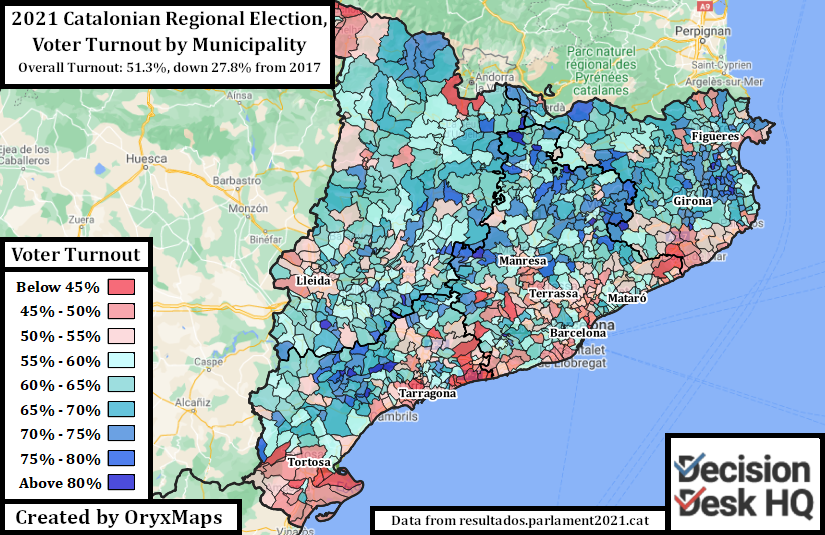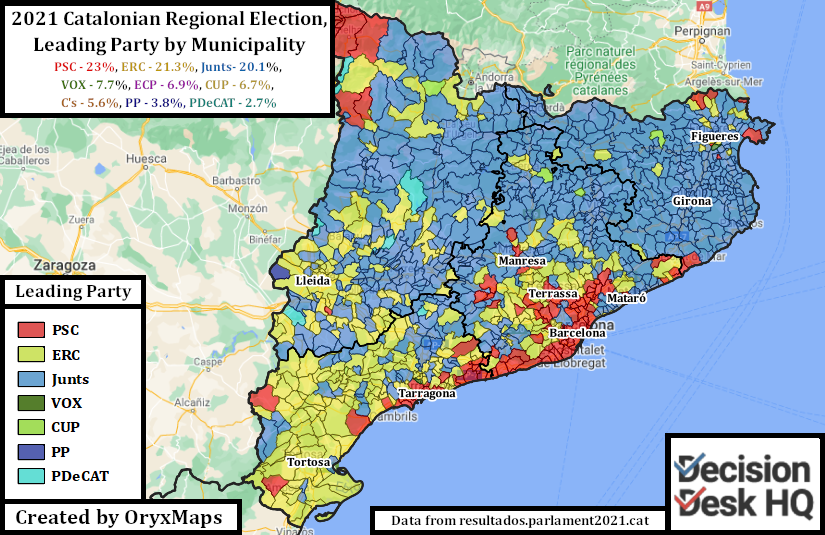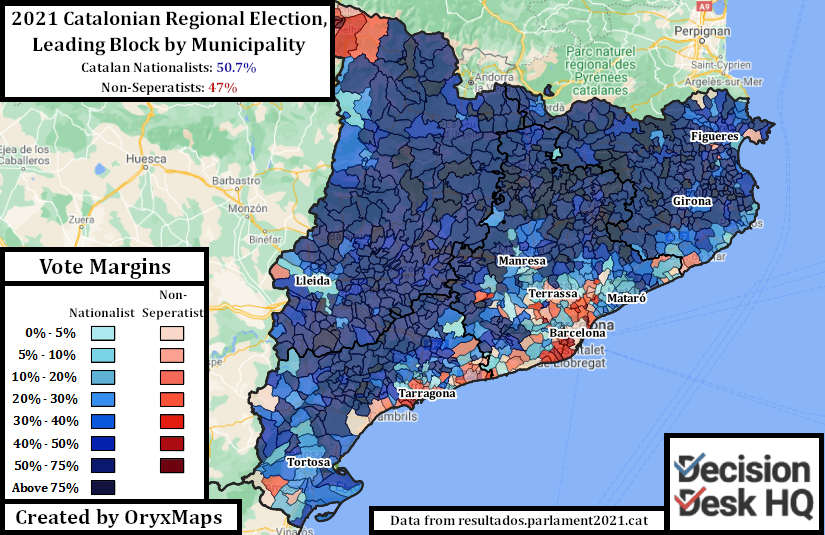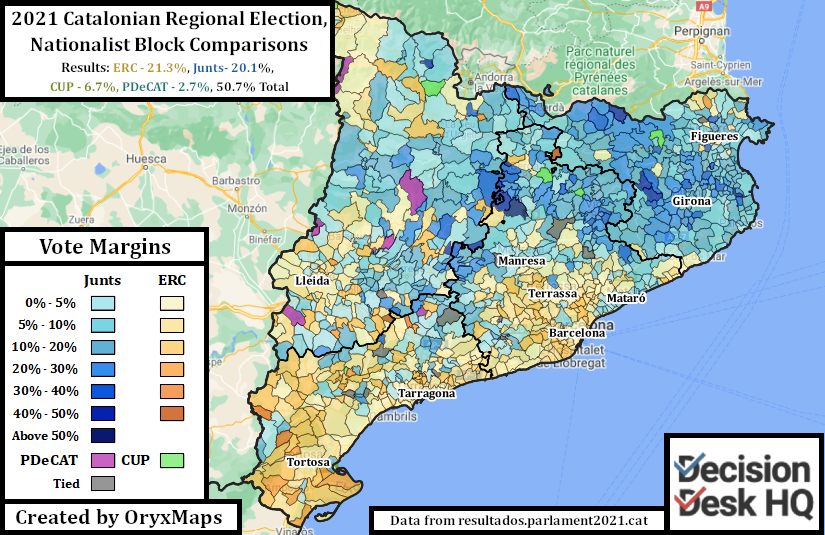An understanding of different political systems offers one a different perspective to their own political arena. Last week Decision Desk previewed the Autonomous Community of Catalonia’s regional elections. With the votes now counted, it is time to analyze the results.
Turnout
This was the lowest turnout regional election in Catalonia’s history. Low turnout was expected given concerns about the Coronavirus pandemic. Over half (53.5%) of voters within the province cast a ballot, and 4.2% of eligible voters living abroad participated, bringing the total turnout to 51.3%. The previous provincial election in 2017 had the highest recorded turnout for a Catalonian regional election at 79.1%. Voters in 2017 were motivated to participate in large numbers, because of that year’s constitutional crisis.

Low turnout eliminates discussion of political swing or voter movement between parties or factions, because any such movement is statistically miniscule compared to the turnout change. The changes in turnout did not affect every party or faction equally. One party, the CUP, received almost the exact same number of votes as in 2017, but won five more seats because their base comprised a greater percentage of the 2021 electorate. Turnout in the rural and Catalonian Nationalist favoring areas was stronger than in the urban and opposition favoring areas. The Catalan Nationalists posted better results than in 2017 by energizing their base of committed voters.
Results
Catalonia uses D’Hondt for allocating the 135 seats in their parliament. Seats are allocated proportionally to the four Catalan provinces, and then awarded based on each party’s results in that province. Vote percentage and seats won can deviate depending on vote efficiency and voter distribution.

Socialists’ Party of Catalonia (Partit dels Socialistes de Catalunya, PSC-PSOE), Spanish Socialists, Federalism. 23% of the vote, 33 Seats.
Republican Left of Catalonia (Esquerra Republicana de Catalunya or ERC), Left-aligned Catalan Nationalism. 21.3% of the vote, 33 Seats.
Together for Catalonia (Junts per Catalunya or Junts/JxCat), Big-Tent Catalonian Separatism. 20.1% of the vote, 32 Seats.
VOX (VOX), Right-Wing Populism and Spanish Nationalism. 7.7% of the vote, 11 Seats.
In Common We Can (En Comú Podem, ECP-PEC), Spanish insurgent Left, nonaligned to either Separatism or Spanish Nationalism. 6.9% of the vote, 8 Seats.
Popular Unity Candidacy (Candidatura d’Unitat Popular, or CUP), Activist Left and Catalonian Nationalist. 6.7% of the vote, 9 Seats.
Citizens (Ciudadanos, C’s), Liberal Spanish Nationalism. 5.6% of the vote, 6 Seats.
People’s Party (Partit Popular, PP), Spanish Conseratives and Spanish Nationalists. 3.8% of the vote, 3 Seats.
Catalan European Democratic Party (Partit Demòcrata Europeu Català, or PDeCAT), Center-Right old-school Catalonian Nationalism. 2.7% of the vote, 0 Seats.
Results Breakdown
The specific coalition of voters that supported each party and faction resembled their previous coalitions and established electoral bases. This was a turnout election. ElDiario.es has interactive scatterplots that compares municipality demographic data against the support for a particular party or coalition. (The nine charts presented in order are: born in Catalonia, born in the rest of Spain, Foreign born, population density, average income, average age, those without a complete education, those with higher education, and voters who abstained and didn’t turn out to vote) This data shows that the only true voter shift was the expected collapse of the 2017 C’s vote; previously C’s consolidated those opposed to Catalan nationalism, but now those voters returned to their previous homes in PSC or the Spanish Nationalist parties.

This was the first election in modern history in which Catalonian Nationalist parties received more than 50% of the vote. The electoral system previously allowed Catalonian Nationalist parties to win more than 50% of the seats, even when they lacked 50% of the vote. Favorable turnout rather than vote transfers from the opposition explains the success of the Catalonian Nationalist parties, but this did not stopped the Catalan Nationalists from seizing the narrative and claiming that a ‘true majority’ of Catalonians support independence.

The composition of the Catalonian Nationalist majority has shifted. The largest Catalonian Nationalist party has always been various Democratic Convergence (CDC) successor parties, mostly recently Junts. Pre-election opinion polls put Junts ahead of the ERC, it was a surprise on election night that the ERC tied the PSC for first place. The ERC does better in urban areas compared to Junts and other post-CDC parties, even though the Catalonian Nationalist strongholds are rural. This peculiarity meant that the ERC was almost always a strong second in Catalonia’s localities – behind the PSC in urban and suburban areas and behind Junts in rural areas and other Catalonian Nationalist strongholds. This allowed the ERC to finish ahead of Junts by 1.2% and by one seat.
Post-Election
Even though the ERC only defeated Junts by exactly one seat, and tied the PSC, everything changes. Junts cannot lead a government, which means the tone of the Catalonian debate shifts. Pere Aragonès, the ERC nominee for the Catalonian Presidency, called this a historic result for Catalonian Nationalism and a signal that it is time for Spain to allow Catalonia to have an Independence Referendum. A few lines in the ERC’s post-election speech were delivered in English not Catalan, neatly summarize the ERC’s plans and how they diverge with Junts. First, Junts’ actions in pursit of a ‘clean break’ based on the 2017 referendum isolated Catalonia and are not the policy of the ERC. Second, the ERC wants a government in Barcelona that backs negotiations with Madrid in pursuance of a legal, legitimate referendum. Third, the ERC recognizes Madrid will not offer a referendum unless pressured, so he delivered a message of cooperation to EU and international observers. Government formation will be difficult, and potential negotiations with Madrid even more so. Time will tell if the ERC’s negotiated approach is allowed to produce different results than Junts’ strategy of confrontation.
Ben Lefkowitz (@OryxMaps) is a Contributor to Decision Desk HQ.